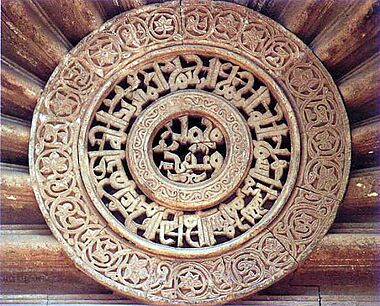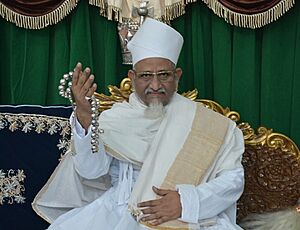Da'i al-Mutlaq facts for kids
The Da'i al-Mutlaq (pronounced Dah-ee al-Moot-lak) is a very important spiritual leader in a group called the Tayyibi Isma'ili community. The name means 'the absolute' or 'unrestricted missionary'.
This leader has guided the Tayyibi community since a time when their 21st Imam (a very high religious leader), at-Tayyib Abu'l-Qasim, went into hiding. This happened around the year 1134 AD.
In the Imam's absence, the Da'i al-Mutlaq holds the highest religious power. They have the same authority as the Imam. Before the Imam went into hiding, the Da'i al-Mutlaq worked under the Imam's direct orders. They helped spread the faith, sometimes openly and sometimes secretly to avoid danger.
In Yemen, after the Imam went into hiding, the Da'i was given full religious and social power. Their decisions are seen as final and guided by the Imam's divine support. Unlike an Imam, who usually chooses his son as a successor, the Da'i can choose anyone. They pick someone they trust who is wise and good at leading the community. The current Da'i for the Dawoodi Bohras is Syedna Mufaddal Saifuddin.
Contents
History of the Da'i al-Mutlaq
According to the Isma'ili Tayyabi tradition, before the 21st Imam, Taiyab abi al-Qasim, went into hiding in Cairo in 1134 AD, his father, the 20th Imam al-Amir, gave instructions. He told Queen Arwa al-Sulayhi in Yemen to appoint a leader after his son went into hiding.
Queen Arwa trained and appointed Syedna Zoeb bin Moosa as the first Da'i in this new role.
Quick facts for kids Dawat-e-Hadiyah Act 1993 |
|
|---|---|
| Act of Parliament | |

|
|
| Long title | An Act to incorporate the Dai al-Mutlaq as a corporation sole; and for related purposes. |
| Citation | 1993 c. x |
| Dates | |
| Royal assent | 1 July 1993 |
|
Status: Current legislation
|
|
| Text of the Dawat-e-Hadiyah Act 1993 as in force today (including any amendments) within the United Kingdom, from legislation.gov.uk | |
In English law, the Da'i al-Mutlaq is recognized as a "corporation sole." This means the office acts like a single legal person, even as different people hold the position. This was made official by a special law passed in 1993.
How a Successor is Chosen: The Tradition of Nass
The way a new leader is chosen is called Nass (pronounced Nahss). This is a very important part of Shia beliefs, as it ensures a clear line of succession. Nass is a special declaration or appointment made through divine guidance.
This appointment is for a successor, whether it's an Imam or their deputy (the Da'i). The current leader chooses their successor, sometimes publicly and sometimes privately. This tradition ensures that the leadership continues without interruption.
According to this belief, each Imam, guided by heavenly commands, chooses his successor. This successor is seen as having the "Light of Imaamat" (Noor al-Imamah). The person who appoints is called the Naas, and the one appointed is called the Mansoos.
This tradition began with the event of Ghadir Khum. There, Prophet Mohammad appointed his son-in-law, Ali bin Abi Talib, as his successor. This practice has continued through all the Tayyibi-Ismaili Imams and Du'aat (plural of Da'i). They believe that neither an Imam nor a Da'i al-Mutlaq can pass away without first appointing their successor.
Deputies of the Da'i al-Mutlaq
The Da'i al-Mutlaq can choose two trusted individuals to help them. These are the Mazoon al-Da'wat and the Mukasir al-Da'wat.
Mazoon al-Da'wat
The Mazoon al-Da'wat is the most trusted helper in the Da'wah (missionary) ranks. This person sits to the right of the Da'i. Their traditional role includes accepting pledges of loyalty from followers on behalf of the Da'i al-Mutlaq.
The Mazoon helps the Da'i with religious activities and always supports their leader. If the Da'i is absent, the Mazoon acts in their place. Often, the Da'i's future successor is appointed as Mazoon. However, this is not a strict rule, and sometimes the successor is someone else. When a Mazoon passes away, the Da'i chooses a new trusted person for the role.
Mukaasir al-Da'wat
The Mukaasir al-Da'wat is the second most important deputy to the Da'i. This person sits to the right of the Mazoon during religious gatherings.
If both the Da'i and the Mazoon are absent, the Mukaasir acts in their place. When a Mukaasir passes away, the Da'i chooses a new trusted person to fill the position.
Current Leaders in Different Groups
Since the office of Da'i al-Mutlaq began, there have been some disagreements about who should be the next leader. This has led to several different groups, each with their own Da'i.
Dawoodi Bohras
The Dawoodi Bohras are the largest group of Tayyibi Ismailis. They follow Dawood Bin Qutubshah as the successor to Da'ud Burhan al-Din I. Their name "Dawoodi" comes from him.
For the Dawoodi Bohras, the current Da'i al-Mutlaq is Mufaddal Saifuddin. The previous Da'i was Syedna Mohammed Burhanuddin, who passed away in 2014. Most Dawoodi Bohras recognize Saifuddin as the 53rd leader.
The main office for the Dawoodi Bohra Da'i is in Mumbai, India.
Alavi Bohras
The Alavi Bohras are a smaller group of Tayyibi Ismailis. They followed Ali Shams al-Din V as the successor to Sheikh Adam Safiuddin. Their name "Alavi" comes from him.
The Alavi Bohras use the Persian form "Da'i-e-Mutlaq" for their leader. The current leader is Haatim Zakiyuddin. He became the leader in 2015, succeeding his father, Abu Hatim Tayyib Ziyauddin.
The main office for the Alavi Bohra Da'i is in Vadodara, India.
Sulaymanis
The Sulaymanis are another smaller group of Tayyibi Ismailis. They followed Sulayman bin Hassan as the successor to Da'ud Burhan al-Din. Their name "Sulaymani" comes from him.
Since 1677, the Sulaymani Du'at have mostly come from the Makrami family. Their main base was in Najran, Saudi Arabia. They ruled that area for a time.
The current leader for the Sulaymanis is Mohsin bin Ali al-Makrami.
Atba-e-Malak Badar
The Atba-i-Malak community is a branch of Musta'ali Isma'ili Shi'a Islam. They separated from the main Dawoodi Bohra group in 1840 after the 46th Da'i al-Mutlaq passed away. This happened under the leadership of Abdul Hussain Jivaji. This group has since split into two more branches.
The Atba-e-Malak Badar is one of these branches. They follow the teachings of both Abdul Hussain Jivaji and Badruddin Ghulam Hussain Miya Khan Saheb. Badruddin Ghulam Hussain Miya Khan Saheb was appointed as a special helper to Moulana Malak (Abdul Hussein Jivaji). The current leader, or Da'i al-Mutlaq, is Maulana Muhammad Amiruddin Malak Saheb.
The Atba-i-Malak Badar community is based in Mahdibagh, Nagpur, India. This community is known for being peaceful and progressive. It was founded in 1899 AD.
Atba-e-Malak Vakil
The Atba-e-Malak Vakil group continues the tradition of Nass (succession) after the passing of the 46th Da'i al-Mutlaq, Syedna Mohammad Badruddin saheb. The leadership passed to four hidden successors. The last of these was Moulana Adamji Tayyebji saheb in Mumbai.
He was followed by Moulana Malak (Abdul Hussein Jivaji) saheb. Moulana Malak then appointed Moulana Abdul Qadir Ebrahimji saheb as his successor, also known as his Vakil. This is where the followers get their name, Atba-e-Malak Vakil.
Their current spiritual leader is Moulana Tayyeb saheb bin Moulana Razzak saheb. This is a very small and peaceful community. Most of its members live in Nagpur, India, with the second largest group in Mumbai. Their main religious texts are the Qur'an and Nasihat (scriptures written by Syedi Sadiqali).
Qutbi Bohra
Taher Fakhruddin claims to be the 54th Da'i al-Mutlaq of the Dawoodi Bohras. He is the oldest son of Khuzaima Qutbuddin, who had also claimed to be the 53rd Da'i al-Mutlaq. This claim came after the 52nd Da'i al-Mutlaq, Syedna Mohammed Burhanuddin, passed away.
Khuzaima Qutbuddin died on March 30, 2016. The next day, his family announced that he had appointed his son, Taher Fakhruddin, as his successor. Followers of Qutbuddin see Fakhruddin as the rightful Da'i al-Mutlaq. However, followers of Syedna Mufaddal Saifuddin do not recognize him.
One of Taher Fakhruddin's first big decisions was about his father's burial. It was decided to bring Khuzaima Qutbuddin's body to India for burial. He was buried at his home in Thane on April 10, 2016. Before the burial, his body was flown by helicopter around Raudat Tahera. This was done to show respect at the mausoleum of his father, the 51st Da'i Syedna Taher Saifuddin, and the 52nd Da'i Syedna Mohammed Burhanuddin.
Khuzaima Qutbuddin had started a court case in 2014 against Syedna Mufaddal Saifuddin. He claimed that only he had been properly appointed by Syedna Burhanuddin. Taher Fakhruddin has continued this court case. However, it was found that Syedna Mufaddal Saifuddin had many documents and witnesses to prove his rightful succession. On April 23, 2024, the Bombay High Court dismissed the case challenging Syedna Mufaddal Saifuddin's position. The court rejected Taher Fakhruddin's claim and confirmed Syedna Mufaddal as the Da'i al-Mutlaq.
See also
- List of Dai of Dawoodi Bohra
- Alavi Bohras
- Succession to 52nd Dai al-Mutlaq




